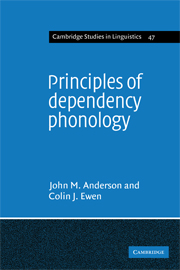4 - The categorial gesture: phonation
Published online by Cambridge University Press: 04 August 2010
Summary
The phonatory components
Jakobson, Fant & Halle (1969:18–19) distinguish two ‘Fundamental Source Features’, i.e. vocalic vs. non-vocalic, and consonantal vs. non-consonantal:
Phonemes possessing the vocalic feature have a single periodic (‘voice’) source whose onset is not abrupt … Phonemes possessing the consonantal feature are acoustically characterized by the presence of zeros that affect the entire spectrum.
Thus vowels are vocalic and non-consonantal, while obstruents are consonantal and non-vocalic. Liquids are characterised as having both the consonantal and vocalic features, i.e. they have some of the acoustic properties both of vowels and of (true) consonants.
For Jakobson, these features are, of course, binary. The appropriateness of the properties characterised by these features, and the way in which they classify segments, are not in doubt, although we interpret them (following Anderson & Jones 1977:123) in a rather different way. We propose two dependency components in the phonatory sub-gesture: |V|, a component which can be defined as ‘relatively periodic’, and |C|, a component of ‘periodic energy reduction’. However, |V| and |C| differ from the vocalic and consonantal distinctive features in that the presence of, say, |V| in a segment does not necessarily imply that the segment is in a simple binary opposition to an otherwise identical segment not containing |V|. Rather, as we noted in §3.4, the more prominent a particular dependency component in a subjunction tree, the greater the preponderance of the property characterised by that component.
- Type
- Chapter
- Information
- Principles of Dependency Phonology , pp. 151 - 184Publisher: Cambridge University PressPrint publication year: 1987



